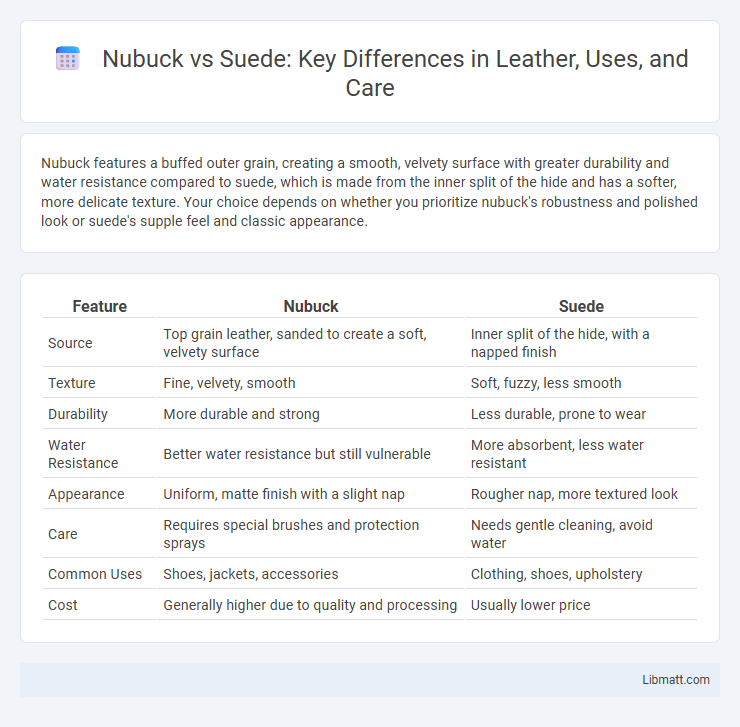Nubuck features a buffed outer grain, creating a smooth, velvety surface with greater durability and water resistance compared to suede, which is made from the inner split of the hide and has a softer, more delicate texture. Your choice depends on whether you prioritize nubuck's robustness and polished look or suede's supple feel and classic appearance.
Table of Comparison
| Feature | Nubuck | Suede |
|---|---|---|
| Source | Top grain leather, sanded to create a soft, velvety surface | Inner split of the hide, with a napped finish |
| Texture | Fine, velvety, smooth | Soft, fuzzy, less smooth |
| Durability | More durable and strong | Less durable, prone to wear |
| Water Resistance | Better water resistance but still vulnerable | More absorbent, less water resistant |
| Appearance | Uniform, matte finish with a slight nap | Rougher nap, more textured look |
| Care | Requires special brushes and protection sprays | Needs gentle cleaning, avoid water |
| Common Uses | Shoes, jackets, accessories | Clothing, shoes, upholstery |
| Cost | Generally higher due to quality and processing | Usually lower price |
Introduction to Nubuck and Suede
Nubuck is a top-grain leather that has been sanded or buffed on the grain side to create a velvety surface, offering durability and a premium look. Suede is made from the underside of the hide, resulting in a softer texture that is more prone to stains and wear. Understanding the differences in texture and durability helps you choose the right material for your footwear or accessories.
What is Nubuck?
Nubuck is a type of top-grain leather that has been sanded or buffed on the grain side to create a soft, velvety surface with a slight nap. It is more durable and resistant to wear compared to suede, which is made from the underside of the animal hide. Used commonly in footwear and high-quality upholstery, Nubuck offers a luxurious texture while maintaining the strength of genuine leather.
What is Suede?
Suede is a type of leather made from the underside of animal hides, primarily from lamb, goat, calf, or deer, known for its soft, velvety texture and delicate nap. It is less durable and more susceptible to stains and water damage compared to other leathers, making it ideal for stylish, lightweight footwear, jackets, and accessories. Suede's unique porous surface requires specific care techniques such as brushing with a suede brush and using protective sprays to maintain its appearance.
Key Differences Between Nubuck and Suede
Nubuck features a top-grain leather surface that is buffed to create a smooth, velvety texture, whereas suede is made from the underside of the hide, resulting in a softer, fuzzier feel. Nubuck tends to be more durable and resistant to wear compared to suede, which is more delicate and prone to staining. When choosing Your footwear or accessories, consider nubuck for longevity and suede for a softer, more supple touch.
Appearance and Texture Comparison
Nubuck features a smooth, velvety surface created by sanding the outer layer of full-grain leather, giving it a sleek, polished look, while suede is made from the underside of the hide, resulting in a softer, fuzzier texture with a matte finish. Nubuck tends to have a more uniform appearance with a subtle sheen that highlights your footwear's quality, whereas suede's napped surface offers a more casual and rustic aesthetic. Understanding these differences in appearance and texture can help you choose the right material for your style and durability needs.
Durability and Wear
Nubuck leather, made from the outer side of the hide, is more durable and resistant to wear compared to suede, which is crafted from the inner split of the leather. The dense grain structure of nubuck offers better protection against abrasions and stains, making it ideal for shoes, furniture, and accessories subject to frequent use. Suede's softer, more porous texture tends to absorb moisture and dirt more easily, requiring careful maintenance to prolong its lifespan.
Care and Maintenance Tips
Nubuck requires gentle cleaning with a soft brush and specific nubuck cleaner to maintain its smooth texture, while suede benefits from a suede brush and eraser to remove stains and dirt effectively. Both materials should be protected with a water and stain repellent spray designed for delicate leathers to prevent damage. Avoid exposure to excessive moisture and direct heat, and allow the shoes to air dry naturally to preserve their durability and appearance.
Common Uses and Applications
Nubuck leather, known for its durability and fine texture, is commonly used in high-end footwear, handbags, and upholstery where a polished yet rugged appearance is desired. Suede, softer and more flexible, is frequently chosen for jackets, gloves, and casual shoes due to its lightweight comfort and breathable qualities. Your selection between nubuck and suede should consider the item's intended use and exposure to elements, as nubuck tends to resist wear better while suede offers a more delicate, velvety finish.
Pros and Cons of Nubuck vs Suede
Nubuck offers a smoother, more durable surface with increased resistance to wear and water, making it ideal for shoes and furniture that need longevity, while its cleaning requires special care to maintain texture. Suede, known for its soft, flexible feel and vibrant appearance, excels in comfort and aesthetics but is more vulnerable to stains, water damage, and abrasion, demanding more frequent maintenance. Your choice between nubuck and suede should consider the balance between durability and softness, as well as the environment where the item will be used.
Which Should You Choose?
Nubuck offers greater durability and water resistance due to its sanding process on the outer leather surface, making it ideal for everyday footwear and outdoor use. Suede, softer and more breathable with its underside leather finish, suits fashion-oriented items where comfort and flexibility are prioritized over ruggedness. Choose nubuck for long-lasting, weather-resistant applications, while suede is better for delicate, stylish pieces requiring a plush texture.
Nubuck vs suede Infographic

 libmatt.com
libmatt.com